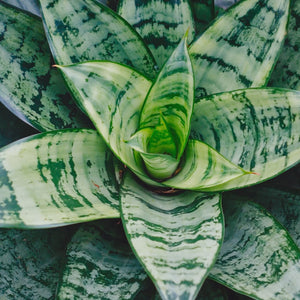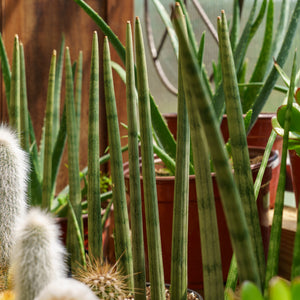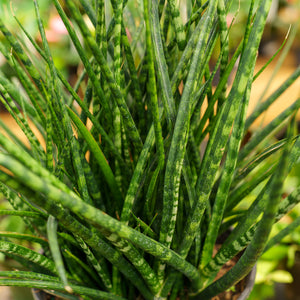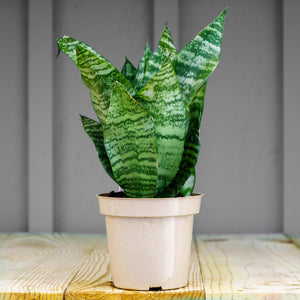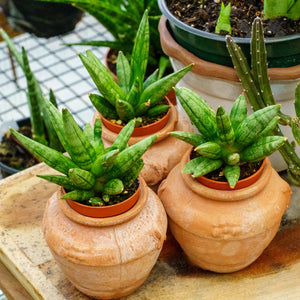The Sansevieria Guide
Sansevieria, more commonly known as snake plant, is one of the most resilient and easy-to-care-for houseplants available. With its upright, sword-like leaves and modern architectural form, it adds clean lines and lush greenery to interior spaces. These drought-tolerant succulents are adaptable to a variety of light conditions, making them ideal for both beginners and experienced plant lovers alike. From the classic Sansevieria trifasciata 'Laurentii' to the striking Sansevieria cylindrica Braided, the genus offers unique textures and colors for any indoor plant collection.

About
Sansevieria belongs to the Asparagaceae family and is native to arid regions of Africa, Madagascar, and southern Asia. It has recently been reclassified under the genus Dracaena, but is still commonly referred to as Sansevieria in horticulture.
- Sansevieria trifasciata varieties like 'Laurentii', 'Moonshine', and 'Black Gold' feature tall, variegated leaves with striking color contrasts.
- Compact selections like 'Hahnii' and 'Whitney' are well-suited to desks, shelves, and small containers.
- Cylindrical forms such as Sansevieria cylindrica, 'Fernwood Mikado', and the braided Sansevieria cylindrica Braided add sculptural flair and are often used in contemporary decor.
- Rare and collector favorites include 'Golden Flame', 'Silver Nymph', and Sansevieria boncellensis 'Hedgehog', which exhibit unique leaf shapes and tones.
Known for filtering indoor air, snake plants are also celebrated for their near-indestructibility and tolerance of neglect.
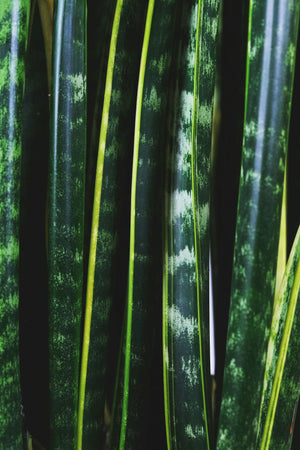
PLANTING
Sansevieria is typically grown as a houseplant but can also thrive outdoors in warm climates:
- USDA Hardiness Zones: Best as a houseplant, but hardy outdoors in Zones 9–11.
- Soil: Use a well-draining cactus or succulent mix. A blend of potting soil, sand, and perlite works well.
- Light: Prefers bright, indirect light but tolerates low light. Direct sun can scorch certain varieties.
- Containers: Choose pots with drainage holes to prevent root rot.
- Planting Time: Any time indoors; spring to early fall for outdoor container placement.
Plant sansevieria slightly above the soil line to prevent rot, and avoid deep planting of offsets or rhizomes.
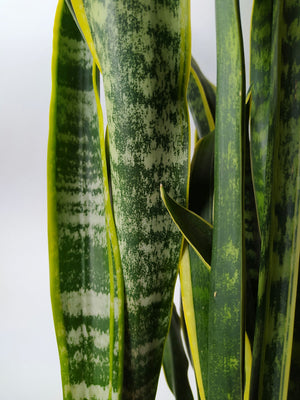
CARE
Sansevieria’s low-maintenance nature is a major part of its appeal:
- Watering: Water deeply, but only when the soil is completely dry. Water every 2–4 weeks depending on the season and indoor humidity.
- Fertilizing: Feed sparingly during the growing season (spring to summer) with a diluted succulent fertilizer.
- Cleaning: Wipe leaves with a damp cloth to remove dust and improve photosynthesis.
- Repotting: Sansevieria prefers to be root-bound. Repot every 2–3 years or when roots are bursting from the pot.
- Pests & Problems: Watch for root rot from overwatering. Mealybugs and spider mites may occasionally appear but are easily managed.
Leaves that droop may signal overwatering, low light, or temperature stress.
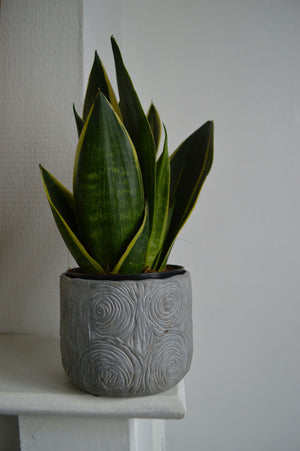
HOW TO USE
Sansevieria brings bold form and reliable greenery to interiors, making it a favorite for modern and low-maintenance plantings:
- Indoor Decor: Perfect for homes, offices, and commercial spaces due to its adaptability and air-purifying properties.
- Tabletops & Desktops: Compact cultivars like 'Whitney' or 'Hahnii' fit easily in smaller pots.
- Floor Plants: Larger varieties such as 'Laurentii Superba', 'Moonshine', or 'Golden Flame' make striking upright accents.
- Group Displays: Combine with ZZ plants, pothos, or peperomia for a mixed arrangement of foliage textures.
- Outdoor Use: In warm climates, use sansevieria in patio pots or xeriscape gardens for vertical interest.
Their clean silhouette and low care needs make them ideal for minimalist interiors or as starter plants for new plant owners.
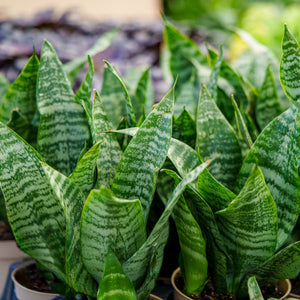
COMMON QUESTIONS
- How to propagate sansevieria? Divide rhizomes or root offsets, or propagate leaf cuttings in water or soil. Variegated types may not retain color patterns from leaf cuttings.
- Is sansevieria toxic to cats? Yes, all parts of the plant contain saponins, which can cause nausea, vomiting, or drooling if ingested by cats.
- Is sansevieria toxic to dogs? Yes, it is mildly toxic to dogs and may cause gastrointestinal upset.
- Do deer eat sansevieria? Rarely. Its tough, fibrous leaves make it unpalatable to deer.
- Do rabbits eat sansevieria? No, it is not typically eaten by rabbits.
- How to care for sansevieria? Provide bright indirect light, water only when soil is dry, use well-drained soil, and avoid overwatering.
- Is sansevieria a snake plant? Yes, “snake plant” is the common name for many Sansevieria species, referring to their upright, pointed leaves.
- Why is my sansevieria drooping? Likely due to overwatering, poor drainage, or insufficient light. Check soil moisture and light exposure.
Conclusion
Sansevieria is a sculptural and reliable houseplant that enhances any space with its bold form, diverse leaf shapes, and hardiness. Whether displayed as a single specimen or grouped with other low-maintenance plants, it delivers year-round greenery with minimal care. With a wide array of cultivars from the stately 'Laurentii' to the compact 'Whitney', sansevieria adapts to every decor and lifestyle.
The Sansevieria Collection
Sold Out
Sold Out
Sold Out
Sold Out
Sold Out
Sold Out

